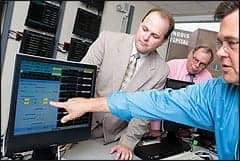Breaking Down Barriers
You don’t have to be mean to handle seven emergency departments across three hospitals and more than 100 offsite locations that combined generate about 1,800 work orders a month, but it does help to be lean.
In this article, Dallas T. Sutton, Jr., CRES, supervisor of clinical engineering at WakeMed Health and Hospitals in Raleigh, NC, sits down with 24×7 Magazine to discuss how streamlining processes and instituting carefully planned policies helps make breaking down the barriers to handling such a massive workload all in a day’s work for the HTM team.
24×7 Magazine: Can you please tell us a little bit about your team and the workload you handle?
Dallas T. Sutton, Jr.: We are a shop of 23, including a director, a supervisor, two site coordinators (Team Leads), and 19 technical positions. We have seven imaging positions, with one vacancy, and 12 Biomed positions with one vacancy.
Our most experienced technician is on the Biomed side and has been at WakeMed since November 1989, and our newest, also on the Biomed side, started in mid-June of this year. We even have a brand-new CBET as of early July.
As far as the workload we handle, we are a 950-bed, three-hospital system with seven emergency departments, and over 100 offsite locations. Our supported inventory is approximately 26,000 devices, and we average about 1,800 work orders a month in total.
24×7: How has your department evolved over the past few years, and how do you see it evolving even more in the future?
Sutton: The biggest change over the past few years has been administrative. The hospital embarked on a Lean Healthcare journey about four years ago and our department has fully embraced this methodology.
We have, through the development of well-thought-out processes and policies, been able to really take command of the work we do. Each technician has grown to become the master of their own business.
We don’t really have to manage day-to-day operations in the traditional sense—there is not a lot of firefighting going on. Instead, we have a daily huddle, 15 minutes max, that sets the tone for the day. We know what the work is and any barriers to getting it done.
For instance, I just pulled out my Leader Standard worksheet and I can tell you that we have 159 open unscheduled Biomed work orders system-wide and 23 of those are actionable, meaning that they are not awaiting parts, access, or vendor service. Of the 159 total, 82% are at the vendor, and we have made great strides in partnering with the biggest offenders to reduce the turnaround of our equipment.
We now have a total of 26 items that cannot be located for PM, and we’re not just closing them, we’re finding them through the implementation of policy. What’s great is that each individual technician knows their own numbers and works very hard to ensure they are moving in the right direction. We now manage the work; the work does not manage us.
24×7: What would your HTM team say are probably the biggest challenges they face day to day?
Sutton: Our team calls them “barriers” as opposed to “challenges,” but the biggest we have had recently is the turnaround time on repairs of common devices by vendors. At one time, we were looking at over two months to get an SCD or IV pump back from repair. There are items that we have a rental agreement, or the vendor won’t sell us parts for (different story), so we were kind of at their mercy. The vendors were identified by our ‘unscheduled workload’ numbers, which we had started to differentiate from ‘awaiting parts’ work orders because it was something over which the team felt they had no control.

Amos Burnett, CBET, a BMET 2 (left), and Jared Zimmel, a BMET specialist, handling paperwork and vendor phone calls in the shop.
When we first entered into discussions with the vendors, I emailed them a pie chart that called out the percentage of our outstanding work with one vendor as compared to other vendors that were also named. This seemed to get their attention. They initiated a sit-down meeting to discuss, and we were able to sort through some administrative and procedural issues, which enabled us to reduce the turnaround time by up to 50% in some cases.
We now display the pie charts for Awaiting Vendor Service and Awaiting Parts in the main shop as ‘The Wall of Shame.’ We now monitor these numbers regularly and go after the next vendor on the list if we feel turnaround times need some attention.
24×7: Can you please discuss a time when your team “saved the day” for another department or another anecdote about the important work your team does every day?
Sutton: I think the most recent event that drove home the importance of our department was a hospital-wide power outage. These, of course, are never fun, but on one Friday night, a transformer blew in such a manner that it prevented the switch to emergency generators and we were dark for about 42 minutes! We ended up with seven staff members either staying or returning to work to assist critical departments with equipment needs.

Adam Charles, CBET, a BMET specialist (left), familiarizes Emily Mengel, a BMET 2, and Aaron Kopping, a BMET 1, with the GE Monitoring Network.
But we really began to shine with the simultaneous failure of a telemetry router and switch, leaving this entire patient population centrally unmonitored. The team was able to quickly identify the switch issue, secure replacement equipment, and work with the IT department to configure it. Once installed, although the patients were now being monitored, it was noted that we still had no HL7 data flowing to the EMR. Further troubleshooting identified the router.
The total downtime from lights out to back up was less than 24 hours, including the shipping time for the new router. The dedication of the staff was outstanding as noted by the clinical leadership of the user departments, as well as several VPs.
24×7: Is there anything else you would like to share about your team and what sets them apart from others with 24×7 Magazine’s readers?
I can tell you from personal experience in having done this for nearly 30 years, that this is the most functional, efficient, and productive shop that I have ever seen or heard about, and it is 100% the result of the dedication of the team.
We constantly receive comments from vendors about how well the shop runs, how well the team works together, how technically astute they are, and how clean they keep the shop. In speaking with various other department leaders around the country, I have found that this shop really is what I consider a benchmark organization. We excel in all aspects of healthcare technology management, and I am proud to be associated with each person on this remarkable team.








Dallas, thanks for sharing about your team! These are great achievements and I cannot wait to learn more about how you and George have embedded lean methodologies in your workflows and processes.